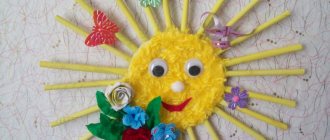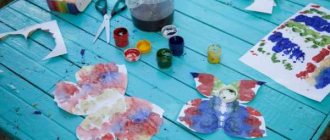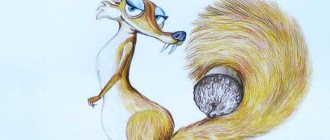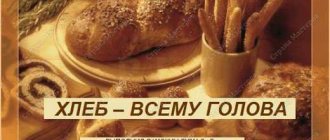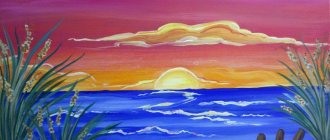Specifics of drawing birds in the senior group of preschool educational institutions
Children 5–6 years old are able to create beautiful, expressive drawings and convey the shape of objects and their components well. Children's horizons broaden significantly: new knowledge is acquired in the process of observing the world around them and reading fiction. The guys can already depict objects that they have never seen (as for birds, this is, for example, a penguin).
The color spectrum with which children work is expanding. The drawing is based on beautiful color combinations.
If in elementary and middle preschool age children depicted birds in the form of checkmarks, then in the older group the teacher’s task is to teach them to draw them correctly. The teacher must form in children an idea of the external appearance of birds, an understanding that they all have a similar structure, although they differ in color, size and shape of body parts. The children learn that all birds have an elongated body and the same head position. When moving, the position of the head and tail changes, and the wings open.
Drawing birds should ideally be preceded by modeling on a similar topic.
In order for preschoolers to realistically depict birds, preliminary work must be carried out before such classes: observing birds on walks, looking at numerous illustrations.
There are some difficulties in drawing birds. Children must learn the basics of depicting them. The drawing begins with an outline - an elongated body in the shape of a large drop (pointed towards the end) and an oval head. After this, wings, a tail, paws and an eye near the beak are added. The accuracy and quality of the entire drawing depends on the correct contour.
The teacher explains to preschoolers how the bird's body parts are located during flight and when moving on the ground (the tail is straightened or folded). In addition, you can draw birds pecking at food or sitting on a tree branch.
Of course, it is better to start depicting birds in the older group with those individuals that children can observe in everyday life: this is a sparrow, titmouse, bullfinch, pigeon, etc. We must teach the children to notice the difference between birds themselves, compare them, highlight key features, then drawing will be easier. For example, an owl is round and fat. The stork is thin-legged with a long graceful beak. The swan has a long neck, is very beautiful, with large, sweeping wings. The penguin seems to be dressed in a tailcoat, clumsy, with short wings, and has a funny crest on its head. The rooster has a powerful chest, strong legs, a beard, a beautiful comb, and most importantly, a multi-colored tail. The bullfinch is distinguished by its red breast.
When preschoolers learn to draw realistic images well, the teacher can invite them to depict a bird in a fairy tale interpretation - “Firebird”, “Bird of Happiness”, “Magic Bird”. Note that this topic is creative, and the teacher offers children several diverse samples for familiarization. In addition, children choose their own colors.
Materials used and base
Birds in the older group are depicted on a sheet of paper of the usual size. When painting with gouache or watercolors, the base is tinted in advance by the teacher. If children have to draw birds soaring in the sky, then it should be a blue background.
For collective work, the teacher offers the children a sheet of whatman paper, where, depending on the nature of the composition, they first draw a tree with many branches, a large feeder, or a village poultry yard.
Preschoolers of this age draw birds with both paints and colored pencils. It is better to paint white birds, for example, a swan, a stork or a goose, with gouache so that they are more visible against a colored background. The same applies to black and white - penguin and swallow. A titmouse, a bullfinch, an owl, a chicken, a sparrow, and a dove can be drawn with colored pencils or even wax crayons. In some cases, felt-tip pens are also suitable, for example, when depicting a bright cockerel.
Drawing with felt-tip pens
To preliminary draw the outline, use a simple pencil.
Techniques and techniques that should be used when drawing in the senior group
When drawing in the older group, the teacher should practice with the children the techniques of correctly painting a silhouette with a brush. Small parts of the body - beak, eyes, paws, tail - are carefully painted on with the tip of the brush. In this case, the instrument should be held in your hand almost vertically. The larger oblong body of the bird and its wings are painted over with all the pile, while the brush is tilted towards the paper. When the paint dries, you can additionally use the tip of the brush to indicate the direction of the feathers - the image will become more realistic.
Hatching with a pencil should be done in one direction, in addition, there should be no white spots inside the outline.
Depending on the size of the part to be painted, preschoolers should adjust the range of their hand movements.
Additional types of visual activities used, the relevance of an individual approach
The image will become more original, and the productive activity itself will be more exciting for children, if you diversify the composition with applicative or plasticine elements. For example, a bird can peck at a worm or caterpillar molded from plasticine (in the form of a flagellum or sequentially stuck balls). Small black eyes of birds can be sculpted from plasticine. If a bird soars in the sky, you can depict the sun using plasticineography. A bullfinch can sit on a rowan branch with sculpted red berries.
Applique details will be especially appropriate when drawing fairy-tale birds. This can be colored foil, shiny sequins or candy wrappers. You can decorate an elegant cockerel in a similar way.
Ordinary bird
Let's try to depict a simple bird.
Master class for beginners:
- Let's start the drawing with the beak, which looks like two triangles, identical in length, only the bottom one is slightly smaller.
- The next step is the oval-shaped lower part of the body.
- We continue the egg-shaped top, and the lines below do not connect.
- It's time for the ponytail. It starts from the first line, going beyond the second, performed in a zigzag manner.
- Now we designate the wing that overlaps the body, and erase the unnecessary strokes.
- All that remains is to apply the paws with sharp claws and the eye-circle, in which the pupil is shifted to the left.
Our picture is ready, now you know how to draw a bird with a pencil. If desired, you can color it.
Specific options for compositions (including collective ones) within the theme
Drawing for senior group students is offered in winter (December). Traditionally, this is the composition “Birds Blue and Red” (based on the poem by the Japanese poet Kitahira Hakushu “Bird, Red Bird”). The children learn to recreate a poetic image in a drawing, choosing the appropriate color palette and beautifully arranging the birds on the base.
A little later (for example, in February), the children can be offered the composition “Birds at the Feeder” (pigeons, tits, crows, sparrows). Moreover, it can be organized as a team effort. Please note that this work must be preceded by modeling.
In winter, it would also be appropriate to draw a bullfinch or a penguin.
After sculpting the rooster (in the spring), the teacher invites the children to draw this beautiful bird. The same applies to the turkey, which is designed as a decorative composition in the form of a Dymkovo toy: children draw this bird with its tail spread like a fan and paint it with characteristic patterns. At the same time, the emphasis is placed not only on object drawing, but on developing a sense of rhythm, color and composition in the design of the pattern.
Drawing birds is good to coincide with April 1, when Fr. On this day, children can depict any bird of their choice or those that preschoolers have not yet drawn (for example, an owl, a swan, a stork, etc.).
At the end of the school year, the children can be offered a creative topic - drawing a fairy-tale bird.
Note that the plots of the drawings can be associated with outdoor games on a bird theme: for example, “Day and Night” (owl), “Dog and Sparrows.” “Birds in the Nests” “Sparrows and the Cat.” These will be plot compositions.
In addition, preschoolers really love drawing based on fairy tales. In this regard, we can offer them the following topics:
- Based on the plots of Russian folk tales: “Hen Ryaba”, “Finist - a clear falcon”, “Winged, shaggy and oily”, “Cockerel and bean seed”, “Brave cockerel” (“Zayushkina’s hut”.
- “The Swan Princess” (based on the work of A.S. Pushkin “The Tale of Tsar Saltan”).
- “Rooster and Paints” (based on the work of Vladimir Suteev)
- “Cuckoo” (illustration for a Nenets folk tale, it could be a bird with a woman’s face and hair)
Older preschoolers enjoy doing work collectively. The teacher can offer them the following topics: “Poultry farm” (poultry), “Poultry canteen”, “Duck with ducklings”, “Hen with chickens”.
Drawing domestic and migratory birds: lesson notes
| Author's full name | Title of the abstract |
| Volokhova O. | "Brave Cockerel" Educational objectives: learn to draw a cockerel with watercolors, conveying its characteristic features and creating an expressive image. Developmental tasks: develop color perception, sense of proportions, improve brush painting technique. Educational tasks: cultivate love and caring attitude towards poultry. Integration of educational areas: “Artistic creativity”, “Cognition”, “Communication”, “Socialization”, “Health”. Demo material: a picture of a rooster, an audio recording of a rooster crowing. Handout: sheets of white paper according to the number of children, watercolors, sippy cups, brushes, coasters, napkins. Progress of the lesson: Teacher's story about a rooster. It turns out that this bird was not always domestic. The ancestors of the rooster from India and China lived in the forest in trees and built nests on the ground. Loud singing was their protection from other birds. Domestic roosters have not lost this habit either. Villagers tell the time by the crow of a rooster. “The first roosters” sound at one o’clock in the morning, an hour later the second roosters sound, and at four o’clock the rooster’s voice is heard throughout the village, announcing that dawn will soon come. The guys look at the image of a rooster and a hen with a chicken, find out how they differ. The rooster is larger, it has a crest on its head, “spurs” on its legs (sharp claws for protection), and bright plumage, especially the tail. The teacher reads a poem about a cockerel.
A conversation about the character of the rooster in this work (brave, courageous, courageous, capable of protecting hens and chicks). He is like this in almost all fairy tales. The teacher asks the children in which fairy tales the cockerel appears. The teacher reports that since ancient times, people believed that the crow of a cock protects the house and embroidered the image of a rooster on towels, tablecloths, and painted it on dishes and furniture. Preschoolers are also asked to pretend to be a rooster. The game “Fighting Roosters” is played: two participants hide their hands behind their backs and, standing on one leg, try to push the opponent out of the circle (with their shoulder or torso). Independent work - drawing a cockerel. Exhibition of children's works. The teacher sums up the lesson and says that the cockerels will protect the children from adversity. |
| Geleverina Yu. | "Wintering Birds" The lesson begins with a game with a ball: children, standing in a circle, take turns naming the bird. Conversation about birds: · Where we meet them (in the city, in the forest, on reservoirs). · how they differ from each other (size, color, singing, habitat) · Where they find food in winter (in feeders, berries on trees). · What can be put in the feeder (bread, grains, seeds, lard). · How birds keep themselves warm in winter (they tuck their legs under them and hide them in the fluff). The didactic game “Cut Pictures” is played: children in pairs pick out images of birds. Physical school is carried out:
Didactic game “Finish the sentence (for example, a magpie is a wild bird, and a chicken...). The teacher reads the poem “Feeder”
Children are invited to draw a wintering bird of their choice. |
| Borodacheva O.V. | "Owl" The lesson begins with a riddle about an owl:
The teacher recalls with the children the fairy tale “The Owl” by V. Bianchi, and knowledge about the significance of this bird in nature is consolidated. Looking at pictures of an owl. Highlighting its distinctive features: large head and eyes, almost no neck, thick plumage. Rounded wings and a short tail help this bird fly silently. The owl's eyes, although large, see practically nothing. Since this bird is a predator, it has a powerful curved beak and sharp claws. The didactic game “Who Says What” is played (children reproduce the voices of various birds). Physical exercise "Owl"
The teacher explains the principle of drawing an owl, and then the children begin the practical part of the lesson (the owl is drawn sitting on a tree branch). Analysis of children's drawings: the teacher asks to highlight the largest owl, the smallest, as well as the sad and cheerful one. The outdoor game “Day and Night” is played. |
| Fomina I.A. | "Swan" At the beginning of the lesson, the teacher tells the children that an artist she knows gave her black and white pictures. We need to figure out together what is depicted on them - the children are shown slides depicting silhouettes of different birds. Preschoolers name them, highlighting characteristic features for each (for example, a swallow has a forked tail, a stork has a long neck, legs and beak). The conclusion is that all these birds are migratory. The didactic game “Finish the sentences” is played (all phrases are related to the swan). Demonstration of a sample image of a swan (swimming in the lake). Discussion on how to complete the drawing. Before working independently, children warm up their fingers by rolling a pencil between them. Independent activity of children. Exhibition of works. The teacher appoints one of the children as a tour guide, and he talks about the children’s works. |
Examples of finished works by senior group students on the topic with comments
The cockerel is one of the favorite birds that preschoolers love to draw. After all, he has such a bright coloring, an elegant comb, a beautiful beard (works “Cockerel”, “Brave Cockerel”, “Dymkovo Rooster”). The chicken in the picture “Ryaba Hen” looks charming.
As practice shows, children also like to portray an owl, since this forest bird of prey has an unusual appearance (compositions “Owl-owl”, Owl - round head”, “Owl with an owlet”).
Swans look beautiful in children's drawings (“Beautiful Swan”, “Swan Princess”). It is worth noting the wonderful collective work “Swans on the Lake”.
Drawing a fairy-tale bird is an opportunity to show your creative imagination and experiment in choosing colors (drawings “Firebird”, “Magic Bird”).
Photo gallery: children's drawings of domestic and migratory birds
Pencil drawing
Drawing with watercolors
Decorative painting with watercolors Decorative painting with watercolors
Teamwork
Gouache drawing
Watercolor drawing
Gouache drawing
Pencil drawing
Pencil drawing
Watercolor drawing
Watercolor and pencil drawing
Pencil drawing
Pencil drawing
Watercolor drawing
Gouache drawing
Pencil drawing
Pencil drawing
Watercolor drawing
Gouache drawing
Birds are one of the topics that encourage unconventional drawing. For example, swans, geese, and doves are often painted with palms (the work “Pigeons”, “Swans”, “Sparrows”, “The Swan Princess”, the collective composition “Birds”). The ruffled feathers of a chicken and a duckling are best conveyed using the poking method (“Chicken and Duckling”). And a shaggy owlet can be depicted using crumpled paper (“Owlet”).
Photo gallery: step-by-step drawing of swans, owls, ducklings and chicks
Palm drawing
Palm drawing
Palm drawing
Poking drawing
Teamwork using unconventional techniques - palm painting
Palm drawing
Drawing with crumpled paper
Finger painting
Palm drawing
Poking drawing
In the older group, it is appropriate to use step-by-step drawing. Based on the diagram, children almost never make mistakes. They are developing an algorithm for depicting a bird, and soon the children will be able to draw birds on their own.
What do you need to prepare for work?
Before you start creating the image of a bird, you should prepare the following materials and tools:
- Plain slate pencils of varying degrees of hardness.
- Soft and hard eraser.
- Suitable paper for sketching.
- If the image is colored, you should get a set of pencils with high-quality leads that leave a bright, rich mark, but do not crumble.
- A picture of the bird itself that will be created.
Please note that the drawing of the original picture depends on the skill level of the draftsman. For beginners, it is better to take a simple image that is fairly easy to reproduce.
For those who are more experienced in drawing, you can take photographic images and reproduce naturalistic pictures.
